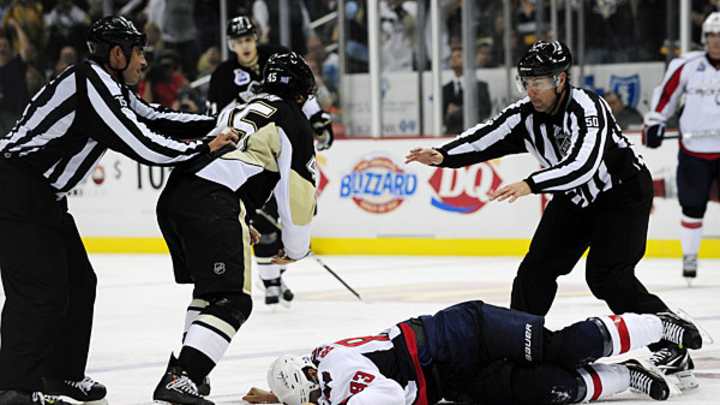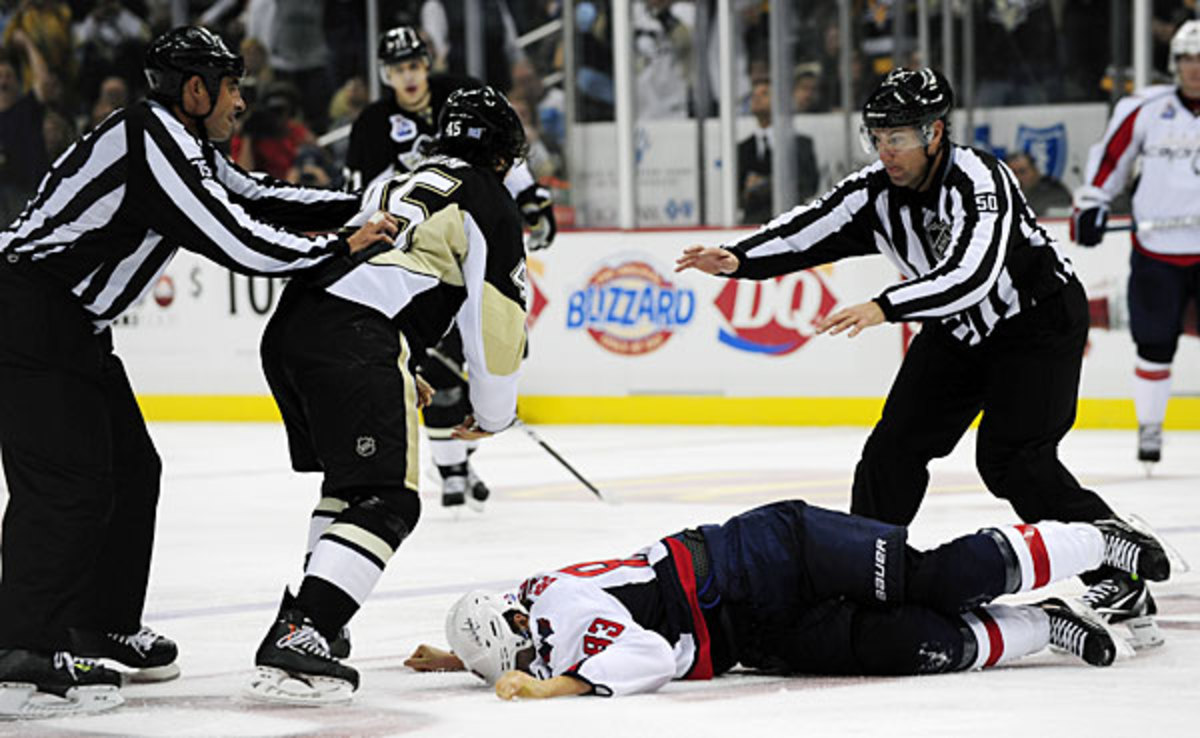Impressions of a hockey fight

The sight of Jay Beagle crumpled on the ice after his short fight with Arron Asham stirred a wide range of emotions that depend on your feelings about the place of fighting in hockey. (Jeanine Leech/Icon SMI)

By Stu Hackel
A couple of bright hockey writers, Jeff Z. Klein and Karl-Erik Reif, once called hockey "our most morally ambiguous sport." If there ever was a more clear example of that ambiguity (a "clear example of ambiguity" -- now isn't that something?), we saw it Thursday night in the fight between the Penguins' Arron Asham and the Capitals' Jay Beagle.
Hockey has always carved out a unique path for itself in the sports landscape, and those who love it always cringe a bit when it -- and the values of its unique culture -- get compared too closely with what goes on in other sports. To put it bluntly, hockey is largely its own animal. That doesnt' mean it exists totally apart from the rest of the world, in its own isolated bubble. There are things that go on in the real world that hockey people cannot ignore, but there are enough different strands of thought within the sport itself to keep you busy for a while.
The Asham-Beagle tussle brought a lot of those strands to the surface. Here it is, from both teams' broadcasts, first Washington's, which gave a better view of how the fight started in real time:
Now Pittsburgh's, which shows the aftermath and, on replay, what led up to it.
This was a one-sided fight and at the end, Asham punctuated his victory by pantomiming the signal a boxing referee makes when a fighter has been counted out, and then someone sleeping. After the game, Asham expressed some legitimate remorse for his celebration, saying it was "uncalled for" and "classless on my part," among other things. (video).
The fight and Asham's demonstration overshadowed the game, a 3-2 Caps win in overtime, a sentiment shared by writers from both Pittsburgh and Washington. And, as if these antagonistic teams needed another reason, it also torched whatever good will might have come from the clubs jointly supporting the families of the Lokomotiv air disaster with the jerseys from this contest now up for auction. Engendering mutual good will would be asking too much from these two teams.
Depending on your orientation, you may very well see something different in this fight than another hockey fan who has another set of concerns about where the NHL is and is going.
Go back 15 years or so and that probably wouldn't be the case. So that's the first perspective we know, the traditional one. Almost everyone back then would find this throw-down pretty entertaining. And for some, that's still what hockey fights represent, pure and simple, perhaps the most passionate part of a passionate sport. They're fun to watch. Well, not if you're Jay Beagle or his family or friends, but chances are, that's not you.
That leads to the second perspective. If you are concerned about the business of the game, you notice that the fans like the rough stuff. They like it a lot. In the corridors of NHL arenas, one used to hear the dark joke, "We'd better stop these fights or people will keep buying tickets."
Perspective three: The way hockey is played and officiated, Jay Beagle did something he shouldn't have done. He roughed up -- just a little, but just enough -- the Penguins' top scorer, Kris Letang, a smaller guy who plays a dynamic but not physical game. Here's where hockey's unique self-policing mechanism snaps into place. Beagle got called for roughing, but that wasn't enough for Asham. He had to avenge the foul.
So Asham defended a teammate who helps create goals for his team. That's his role, part of what he's employed to do. And he does it pretty well. If you don't have guys like Asham on a team, you run a serious risk of having your best players abused. This isn't appointment fighting, this is a spontaneous reaction to a game situation. (Now, sometimes a guy like Asham will retaliate against a opponent who has thrown a perfectly legal body check. It's something that has crept into the game in recent years with its own rationale. But that's not exactly this, so we'll leave that for another day).
And that's exactly the position taken by Barry Melrose on ESPN:
Melrose adds a fourth perspective: Asham was trying to fire up his team. The Pens were trailing when the fight took place and, as Melrose saw it, they began to carry the play and eventually tied the score only to lose in overtime. But they got a point out of it and that may not have happened had Asham not dropped his gloves and dropped Beagle. Melrose completely overlooks Asham's post-fight gesture.
That's not how they saw things on TSN, however. This segment aired earlier than Asham's post-game act of contrition:
In the collective view of this group, we have a fifth perspective: Asham's animated response in the aftermath of the fight is universally condemned as "graphic bad taste" and "bush league," and considered to be "more along the lines of professional wrestling than professional hockey." Hockey culture, being what it is, has a fascinating canon of do's and don't's and you don't celebrate a fight where your counterpart is semi- or unconscious.
And yet Bob McKenzie in that segment, with Marc Crawford nodding his agreement, was willing to simultaneously entertain a sixth perspective: that no fighter with his adrenaline pumping can be expected to shut off that excitement a millisecond after his vanquished foe has crumpled. Upon reflection, Asham recognized he was wrong and acted accordingly. He admitted to getting carried away by the moment, which is better than not apologizing. UPDATE: Ken Campbell of The Hockey News has an opposing view, that Asham should be suspended (read that here). "If Nick Boynton can receive one game for making a throat-slash motion last season, surely to goodness the NHL can find a way to indicate to Asham and everyone else in the league this kind of bush league behavior is an embarrassment," he writes. So that's another perspective.
Without question, there is an important and ever-present seventh perspective: that fighting shouldn't be permitted in hockey under any circumstances. People who adhere to that belief don't see why it's needed in the game, and consider it harmful to hockey's growth. They react with horror while questioning the priorities of anyone who is more concerned with justifications and gestures than Beagle lying on the ice in distress. They contend that if referees did a better job of enforcing the rules as they are written, there would be far fewer reasons for players to square off. They would probably also question why, as Bruce Boudreau did, Asham was able to avoid getting an instigator penalty on the play.
And there is an eighth perspective here, a newer variation on seven: Rather than debating the place of fighting in the NHL, this view contends that if the league is serious about curtailing behavior that causes brain injury -- and Beagle certainly looked like he suffered one -- fighting cannot continue to be part of the sport. People who carry that banner see Beagle crumpling, note how mismatched these two were, and make the case that this sort of incidents poses as much danger to the game as an elbow to the head or being run from behind into the boards. It was a point that Hockey Hall of Famer Ken Dryden made on the CBC news program The National earlier this week (video): that hockey fights no longer feature two guys unsteadily flailing away at each other, as they might have 40 years ago. Today, players like Asham train for these moments and that's one reason more serious damage seems to occur in a hockey fights now than in the past.
If there's another sport that has a single situation that gives rise to so many varied, interlocking yet opposing viewpoints, I can't think of it. Each of these perspectives has some logic to it. That's one reason hockey can take so long to turn.
